Key Insights
- Polygon committed $1 billion and raised $450 million to focus on multiple ZK-scaling efforts. The strategy allows independent teams to experiment with different scaling approaches, while fostering intense collaboration and information sharing.
- In general, network-wide activity increased during the third quarter with active addresses setting an all-time-high of 6 million, new addresses spiking 180% QoQ, total unique addresses surpassing 170 million, and total transactions surpassing 2 billion.
- The different sectors yielded mixed results: DeFi was down QoQ, gaming was up significantly YoY, and NFTs set an all-time-high in active wallets.
- Polygon continued its aggressive business development strategy, announcing new partnerships with Acentrik, Disney Accelerator, Reddit, Robinhood, Starbucks, and Worldpay.
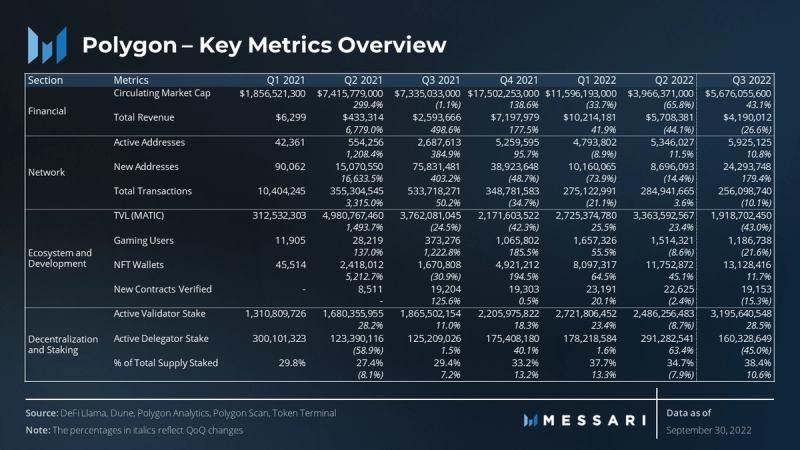
Primer on Polygon
Polygon intends to be a general purpose scaling solution for Ethereum. It is actively developing multiple Ethereum scaling solutions including ZK-rollups, Optimistic Rollups, Sidechains, a Data Availability Layer, and a blockchain SDK analogous to the Cosmos SDK or Substrate. The earliest and most widely used of the scaling solutions is the Polygon Proof-of-Stake (PoS) sidechain. Additionally, Polygon is pursuing an aggressive business development strategy partnering with both Web3 and legacy companies, operating a venture arm, and developing a decentralized identity solution Polygon ID.
Performance Analysis
Today, the Polygon Proof-of-Stake (PoS) chain is responsible for nearly all of Polygon’s activity. The PoS chain is an Ethereum sidechain. Everything in the performance analysis section pertains to the PoS chain, unless otherwise specified.
Financial Overview

During Q3, while the entire crypto market cap was relatively flat, Polygon’s market cap was up 43% QoQ. The increase began in early July, following the announcement that Disney chose Polygon to participate in the Disney Accelerator. This continued with a slew of new partnership announcements including with Acentrik, Reddit, Robinhood, Starbucks, and Worldpay.
In August, 1.4 billion MATIC (14% of the total supply) was moved from a vesting contract to staking or the Polygon treasury. Polygon closed the quarter with 9.7 billion MATIC, 97% of the total supply in circulation. The remaining 270 million MATIC in the vesting contract will be unlocked in October and absorbed into the treasury.
Total revenue for Q3 was $4.2 million, down 26% QoQ. The drop was driven by a 10% decline in transactions and a 51% decline in transaction fees to an average of $0.09. For comparison, Avalanche had $2.3 million in quarterly revenue (-94% QoQ) with a $0.14 average transaction fee, and Solana had $4.8 million in revenue (-25% QoQ) with a sub-one-cent average transaction fee.

On Jan. 1, 2021, the Polygon treasury had a massive war chest of 4.6 billion MATIC. On Aug. 13, 2021, Polygon announced a strategic focus on ZK-based scaling solutions and $1 billion in treasury funding for this effort. The allocated funds were used for:
- Acquiring ZK-projects and teams
- Building ZK-based solutions
- Hiring talent
- Research funding
Use of the treasury is centrally controlled by Polygon Technologies, and the majority of expenditures to date have been related to the ZK-scaling efforts.
The same day the strategic focus on ZK-scaling was announced, Polygon announced the first major treasury expenditure with the acquisition of the ZK-rollup Hermez Network (now Polygon zkEVM) for 250 million MATIC (approximately $250 million). On Dec. 9, 2021, Polygon announced its second acquisition in Mir Protocol (now Polygon Zero) for $100 million and 190 million MATIC. At the end of Q3, the Polygon treasury had 2.4 billion MATIC (down 48% from the 4.6 billion).
Network Overview
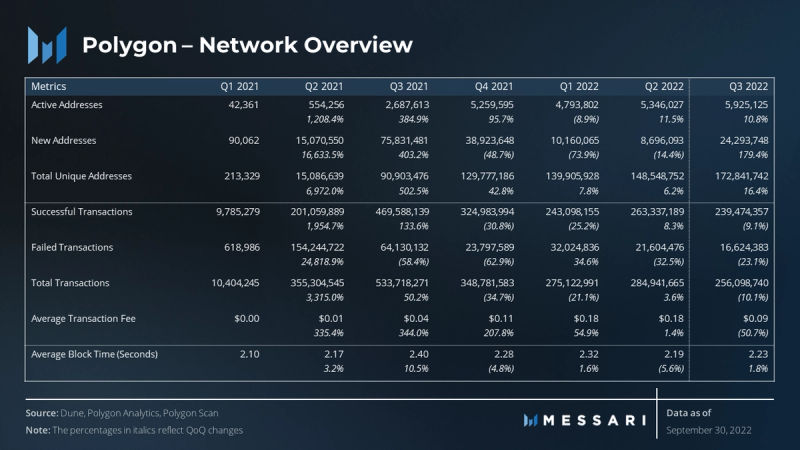
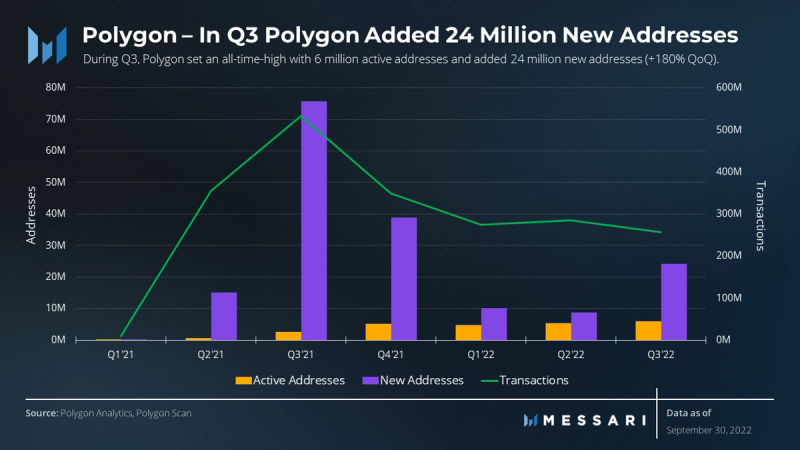
During Q3, account-related metrics were positive QoQ. Active addresses increased for the second consecutive quarter and set an all-time-high of nearly 6 million active addresses. New addresses spiked 180% QoQ primarily due to the launch of the Reddit NFT marketplace. Total unique addresses surpassed 170 million and are on track to surpass 200 million by the end of the year.
Despite the increase in accounts, total transactions dropped 10% QoQ to 256 million (-50% from all-time-highs). For comparison, the Avalanche C-Chain registered approximately 20 million transactions (-66% QoQ) and Solana non-vote transactions 3 billion (+70% QoQ). The massive increase in new accounts paired with the decrease in transactions suggests that new users have not demonstrated activity, but it is still early.
Ecosystem and Development

During Q3, the different sectors of the Polygon ecosystem yielded mixed results. Total Value Locked (TVL) in MATIC declined 43% QoQ but remains relatively flat on a year-to-date basis. Gaming also saw significant QoQ declines, primarily concentrated in the months of July and August. In September, gaming users spiked 96% MoM driven by the launch of the hit game Benji Bananas. NFTs had the strongest quarter, setting an all-time-high in active wallets.
Polygon’s gaming and NFT sectors are components of Polygon Studios, a relatively new piece of the Polygon ecosystem. Studios is led by the former Head of YouTube Gaming Ryan Wyatt. Like Polygon’s business development team, Studios has been aggressively investing and signing partnerships.
DeFi
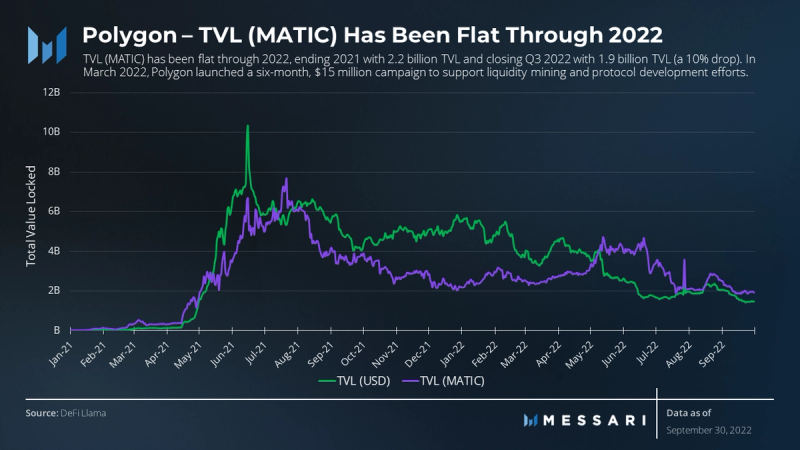
The decrease in Polygon TVL (-43% QoQ) coincided with Arbitrum and Optimism launching their respective liquidity mining campaigns. Nonetheless, Polygon’s TVL has been flat through 2022, ending 2021 with 2.2 billion TVL and closing Q3 2022 with 1.9 billion TVL (-10%). For comparison, Avalanche ended Q3 with $1.9 billion TVL (-28% QoQ), Binance $6.6 billion (+11% QoQ), and Solana $2.1 billion (-16% QoQ).
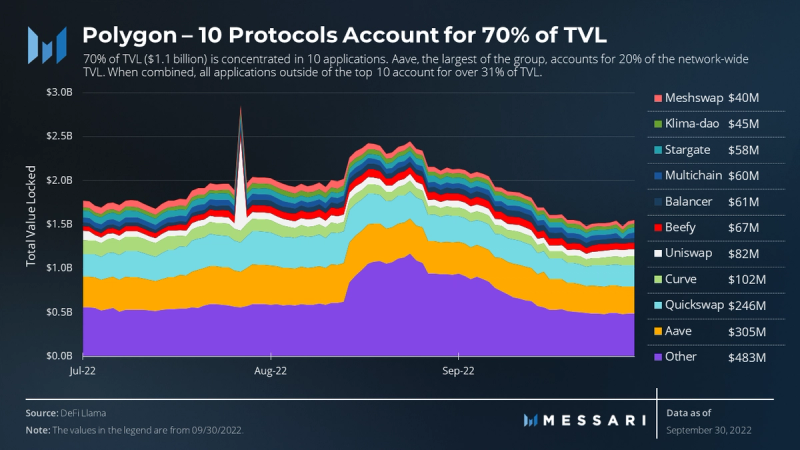
Of the TVL on the Polygon Network, 70% ($1.1 billion) is concentrated in 10 applications. Aave, the largest of the group, accounts for 20% of the network-wide TVL. Of Aave’s TVL across all networks, Polygon accounts for 6%, while Ethereum accounts for 70%. All applications outside of the top 10 account for over 31% of TVL.
As expected, Uniswap is the dominant decentralized exchange measured by DEX volume. In the final week of the quarter, over 70% of trading volume on Polygon was completed through Uniswap. Aggregators account for 12% of trading volume, with 1inch (55%) and Paraswap (33%) controlling the majority of the volume.
Overall, Polygon’s TVL has remained steady, despite the bear market and minimal liquidity mining incentives. The minimal incentives are in contrast to optimistic rollups and Ethereum scaling competitors (Arbitrum and Optimism) launching their respective liquidity mining campaigns. Despite minimal incentives and increased competition, the consistency suggests organic, sticky DeFi activity.
Gaming
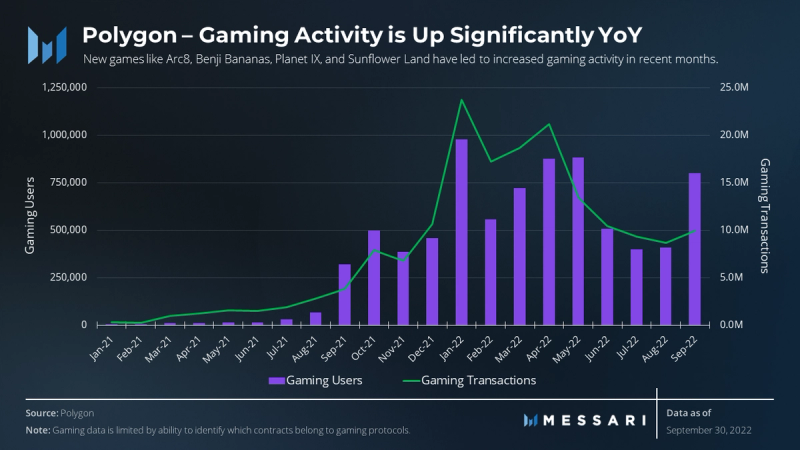
Polygon gaming activity is up significantly YoY. In 2021 and early 2022, the largest games on Polygon were high-profile names like Aavegotchi and The Sandbox. In recent months, new games like Arc8, Benji Bananas, Planet IX, and Sunflower Land have led to increased activity. Polygon has multiple new games in development across a variety of genres including MMORPGs, first-person POVs, etc.
NFTs
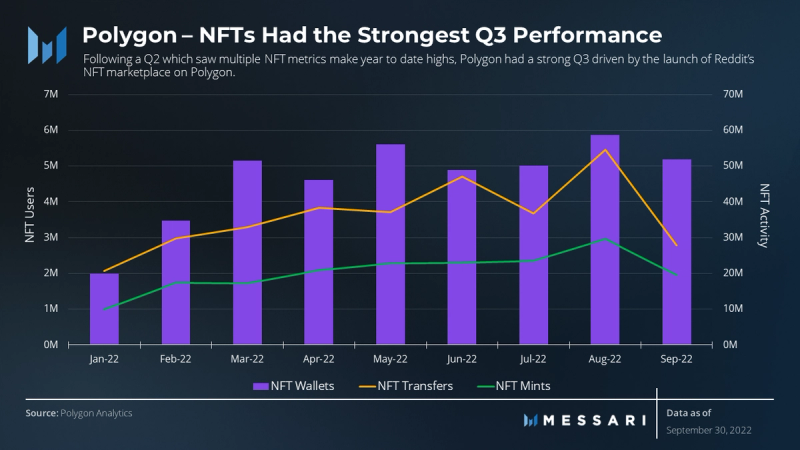
Following Q2, which saw multiple NFT metrics make year-to-date highs, Polygon had a strong third quarter setting an all-time-high in active wallets. The spike in activity was driven by the launch of Reddit’s NFT marketplace on Polygon. Initially, the NFTs were only available to members of the r/CollectibleAvatars invite-only subreddit but were later made accessible to the public. This led to a surge in activity (Note: The Reddit NFTs have continued to surge into Q4). Zed Run, a digital horse racing game, remains the largest collection on Polygon by far, with lifetime sales of nearly $200 million.
Additionally, Polygon added to an already lengthy list of prominent NFT partners by inking new partnerships with Disney, Robinhood, and Starbucks:
- Disney Accelerator – Polygon was selected as one of six companies to join the Disney Accelerator, a business development program focusing on building the future of immersive technologies with augmented reality, NFTs, and artificial intelligence. Over the course of the program, each participating company will receive guidance from Disney’s senior leadership team and a dedicated executive mentor.
- Robinhood Web3 Wallet – Robinhood chose Polygon to support its newly launched non-custodial Web3 wallet. The Robinhood Wallet beta is now live for 10,000 iOS customers and will primarily support DeFi functionality. When the full version of the mobile app is released, it will support a wider variety of assets including NFTs.
- Starbucks Odyssey – The partnership will allow Starbucks Rewards loyalty program members and Starbucks employees to earn and purchase digital collectible stamps in the form of NFTs. The campaign has yet to launch.
The partnership with Reddit quickly yielded promising results, with on-chain NFT activity spiking. It is no stretch to imagine the new partnerships will lead to further increases in activity.
Developer Activity
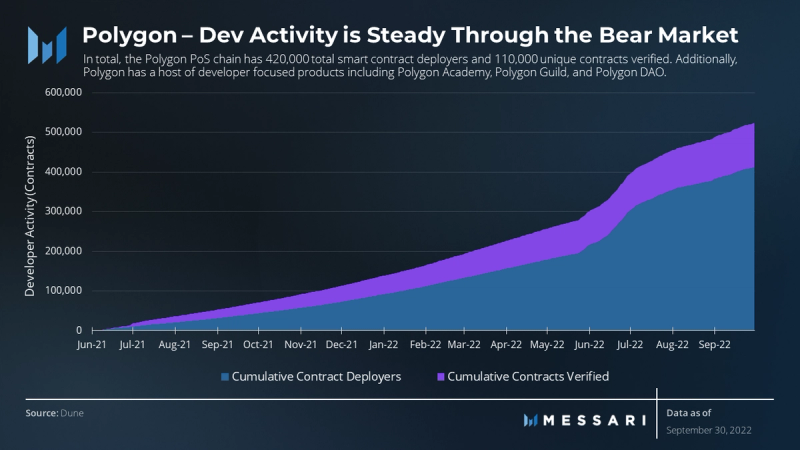
With multiple scaling solutions in development, it is no secret that Polygon continues to build through the bear market. This includes the PoS chain, which has maintained healthy levels of development. In total, the Polygon PoS chain has 420,000 total smart contract deployers and 110,000 unique contracts verified.
To continue promoting development, Polygon has released a number of developer-focused products including:
- Polygon Academy – A free online school dedicated to onboarding developers.
- Polygon Guilds – A platform for developers to organize monthly meetings, collaborate with other developers, conduct workshops, and facilitate a host of other activities.
- Polygon Village – A full-stack developer-centric ecosystem including: welcome vouchers with leading applications, grants programs, a three-month pre-acceleration cohort with dedicated mentorship and support, a job board, and a bounty board. In July, Polygon Village announced support for DAO operations and tooling.
Polygon also committed $1 million in Gitcoin grants, launched a 50-spot fellowship, and launched the #BUIDLIT Hackathon with $500,00 in prizes.
Decentralization and Staking
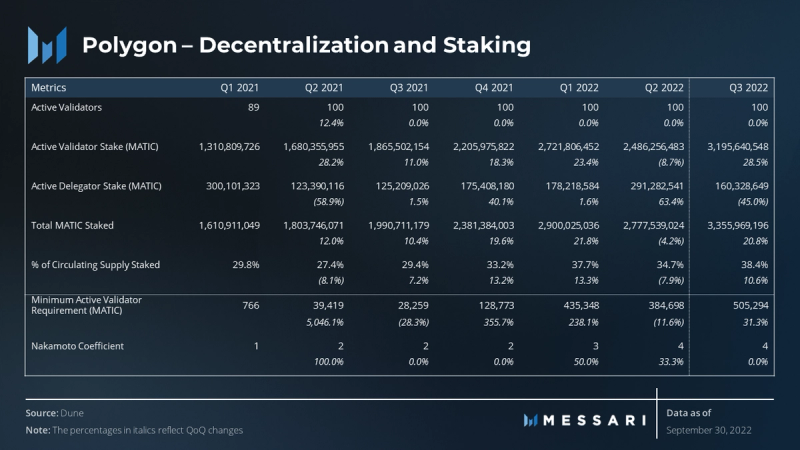
The Polygon PoS chain is broadly divided into three layers: Ethereum, Bor, and Heimdall. The Ethereum layer houses the staking contracts, which give the PoS chain greater levels of security. The Bor layer aggregates transactions into blocks and handles similar duties to the Ethereum Beacon Chain. The Heimdall layer sends periodic checkpoints from Bor to the Ethereum Mainnet for finality. Anyone who wishes to become a validator on Polygon must run both Bor and Heimdall nodes and stake their MATIC in the MATIC staking contracts on Ethereum.
Today, there is a limit of 100 active validators at a time. While the validator set can theoretically scale to greater decentralization, it has a maximum of 100 to maintain the quick block times. New validators can join the active set when a currently active validator unbonds. Polygon allocated 12% of the total supply (1.2 billion MATIC) toward staking rewards, with over 600,000 MATIC paid out thus far.
To arrive at a state of absolute decentralized self-governance, the validators must self-regulate network participation to an agreed-upon set of parameters. The process of decentralization must be gradual to ensure the network can operate and scale smoothly. Polygon Improvement Proposal 4 (PIP-4) proposes to increase the maximum validator set to 105. If the proposal passes, it will be an early step to decentralization.
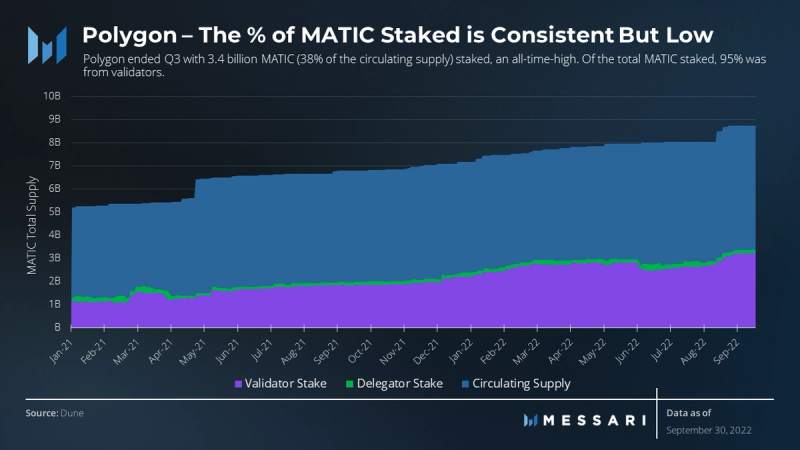
Polygon ended Q3 with an all-time-high of 3.4 billion MATIC staked (38% of the circulating supply). The 21% QoQ increase in MATIC stake was due to the Polygon team staking their tokens received from the 2021 vesting unlock. Of the total MATIC staked, 95% was from validators. Just three validators produced over 30% of all blocks in many weeks this quarter, with the top six validators producing over 50% of the blocks. As a result, Polygon has a Nakamoto coefficient of four, putting it below the industry average. Overall, Polygon staking and decentralization metrics have been consistent, suggesting continued network health.
Qualitative Analysis
Scaling Solutions

Polygon’s mission is to help scale Ethereum. To succeed, the core team recognized Polygon needed to expand beyond the PoS sidechain and focus on ZK-technology. As a result, Polygon committed $1 billion and raised $450 million to focus on multiple ZK-related scaling efforts. Polygon’s strategy allows independent teams to experiment with different scaling approaches, while fostering intense collaboration and information sharing that otherwise would not be possible.
Polygon Avail
Polygon Avail is a general purpose, scalable data availability layer for standalone chains, sidechains, and modular chains. A rollup using Avail for data availability can completely circumvent the need for a monolithic L1, making it sovereign. Avail can act as a validium for Ethereum, taking data off-chain and providing data availability for chains on other networks. Avail is hyper-efficient because it uses random sampling to determine data availability, a process that Celestia and Ethereum 2.0 intend to implement. Avail is currently live on testnet.
Polygon Edge and Supernets
Polygon Edge is a modular blockchain development framework designed to support a variety of scaling and infrastructure solutions for developing Ethereum-compatible chains. Similar to Substrate (Polkadot) or the Cosmos SDK, Edge facilitates the development of application-specific chains.
In April 2022, Polygon announced Polygon Subnets. These application-specific, EVM-compatible, blockchains are designed to mitigate commonly identified challenges and extend the Edge framework. Supernets will have the option to source security from MATIC stakers to skip bootstrapping a validator set, communicate with the Ethereum Mainnet and other Supernets, and offer dedicated developer teams (known as Edge Certified Partners) for maintenance support. Soon, Supernets will be able to leverage Ethereum’s security and data availability (or Polygon Avail’s) to take the form of a rollup or validium. Polygon is committing $100 million for the development and adoption of Supernets.
Polygon Miden
Polygon Miden is a ZK-rollup with a focus on generalized programmability. Miden batches transactions off-chain similar to zkEVM and Zero; however, arbitrary smart contracts are difficult to roll up. To overcome this, Polygon Miden is being built around the Miden Virtual Machine. The virtual machine has been specifically optimized to support arbitrary logic written in Solidity and other languages.
While Miden supports Solidity, it is not fully EVM compatible in the way Polygon zkEVM aims to be. Miden uses STARKs instead of SNARKs for proofs, meaning there is no trusted setup required, it’s more scalable, and it’s quantum resistant. Miden is scheduled for testnet development in the near future.
Polygon Nightfall
On Sept. 14, 2021, EY and Polygon announced a partnership to develop Polygon Nightfall, an optimistic rollup with a focus on privacy for enterprises. Nightfall is a self-described “hybrid optimistic-zk rollup” because it uses fraud proofs (optimistic rollups) and validity proofs (ZK-rollups). Nightfall uses a validity proof to obfuscate the data and then a fraud proof to batch it to the mainnet. Similarly, Aztec is referred to as a “recursive zk-rollup” because it uses a validity proof to obfuscate the data and then another validity proof to batch it to the mainnet.
The process of batching transactions and sending them back to the mainnet on Nightfall is strictly set up as an optimistic rollup and only uses fraud proofs for verification. The ZK-rollup name and validity proofs are strictly for privacy and obfuscation of data. Nightfall is currently in mainnet beta.
Polygon Zero
On Dec. 9, 2021, Polygon announced that they were acquiring Mir Protocol for $400 million. Mir Protocol, re-branded to Polygon Zero, is a ZK-rollup with a focus on speed. Zero settles batched transactions on the mainnet with a validity proof like Polygon zkEVM. Except, Zero uses a novel recursive SNARK called Plonky2. Recursive proofs allow for horizontal scaling, and the Plonky2 proof system allows for the proofs to be small and fast. Plonky2 is a combination of PLONK and FRI proof systems and was created by the Zero team. In August, it was open-sourced and is scheduled for testnet in Q4 2022.
Polygon zkEVM (previously Polygon Hermez)
On Aug. 13, 2021, the same day the team announced the $1 billion ZK-scaling commitment, they announced Polygon’s first foray into the ZK-scaling field with the acquisition of the ZK-rollup Hermez Network for 250 million MATIC (approximately $250 million). The primary focus of the Hermez Network is to develop a zero-knowledge implementation of the Ethereum Virtual Machine (EVM) to minimize friction when deploying smart contracts directly on a ZK L2. Because the EVM was not created with ZK-proof support, the team needed to re-create all of the EVM opcodes from scratch to support ZK-tech, a massive undertaking.
In July 2022, the Polygon team unveiled Polygon zkEVM (re-branded from Hermez 2.0). The announcement included the open-sourcing of the zk-EVM’s code and plans to launch a public testnet in H2 2022. Coinciding with the zkEVM announcement, Vitalik released a blog post describing the different zk-EVM solutions. He used a taxonomy from types 1-4, with type-1 being a fully Ethereum-equivalent optimal state and type-4 being a high-level language equivalent. Vitalik described Polygon zkEVM in its current state as a type-3 with the potential to move to type-2 proceeding additional releases (Note: The Polygon zkEVM testnet went live in October).
Polygon ID
Although not an Ethereum scaling solution, Polygon ID is another product being developed by Polygon. Polygon ID is a decentralized, self-sovereign identity solution allowing fully private and verifiable on-chain verification using ZK-cryptography. Polygon ID addresses know-your-customer requirements, while simultaneously allowing users to retain total privacy. Theoretically, on-chain identification systems like Polygon ID can be used ubiquitously across crypto. However, specific use cases include a decentralized credit score, DAO voting rights, and exclusive gaming guild access.
In June, Polygon announced the integration of Polygon ID with Polygon Village. The integration allows Polygon to begin testing Polygon ID and the Polygon Village to start testing novel governance frameworks. The Polygon ID ecosystem plans to include two new products. Polygon ID Platform is a public platform developers and organizations can use to define and manage the trust lifecycle of their applications and other requirements. Polygon ID connect is a public service platform to integrate access across the native app and applications. Following the crackdown on Tornado Cash, on-chain identification and KYC have re-entered the spotlight.
Business Development
Polygon has positioned itself to be a trustworthy partner for legacy brands interested in exploring Web3. In some cases, it seems Polygon has been chosen not only to help build out a Web3 solution but also to help businesses identify their market fit and Web3 use cases through incubator programs.
NFTs and integrations on Polygon are being used by legacy brands across different industries including social media, retail, sports, financial services, and gaming. Additionally, Polygon has built a developer-friendly environment that has led to many popular DeFi protocols and Web3 services deploying on Polygon PoS. Aave, Uniswap, and Lido can all be used on PoS, and OpenSea also supports NFTs on Polygon PoS.
The recent increase in activity, spurred by the Reddit NFTs, was a huge victory for Polygon’s business development strategy. The newly signed partnerships should be coming online in the coming months. Look for Polygon to continue its aggressive business development approach.
Closing Summary
Despite the ongoing bear market, Polygon continues to build at a heightened pace. During Q3, Polygon saw network-wide activity increase, continued its aggressive business development strategy with new partnerships with distinguished companies, and progressed on its ZK-scaling efforts with the unveiling of Polygon zkEVM.
Polygon’s financial and network activity reflects Polygon PoS activity. During Q3, revenue was $4.2 million, a 26% QoQ decline driven by a 10% decline in transactions and 51% decline in transaction fees. Polygon average transaction fees were $0.09, so revenue is not expected to be significant. The Polygon treasury ended the quarter with 2.4 billion MATIC ($1.8 billion).
In general, account-related metrics increased during the third quarter with active addresses setting an all-time-high of 6 million, new addresses spiking 180% QoQ, total unique addresses surpassing 170 million, and total transactions surpassing 2 billion. The NFT and gaming sectors led the increases with the launch of the Reddit NFT marketplace and the hit game Benji Bananas. Despite the increase in accounts, total transactions dropped 10% QoQ to 256 million (-50% from all-time-highs), and TVL dropped 43% QoQ. The declines are attributable to Arbitrum and Optimism launching their respective liquidity mining campaigns and new users still demonstrating limited on-chain activity.
Decentralization and staking-related metrics were consistent. As of Sept. 30, 2022, there is a limit of 100 active validators at a time to maintain the quick two-second block times. The newly introduced Polygon Improvement Proposal 4 (PIP-4) proposes to increase the maximum validator set to 105, a potential first step in a progressive path towards decentralization. Additionally, Polygon set an all-time-high with 38% of total supply staked (+21% QoQ) due to the Polygon team staking their tokens received from the 2021 vesting unlock.
Polygon’s focus on ZK-scaling and aggressive business development continued. The unveiling and open-sourcing of the Polygon zkEVM was a monumental milestone, as it was the first open-sourced zkEVM. The business development team signed new partnerships with Acentrik, Disney Accelerator, Reddit, Robinhood, Starbucks, and Worldpay. The early success of the Reddit marketplace is an encouraging sign that the aggressive business development strategy is paying off.
By allowing independent teams to experiment with different scaling approaches, Polygon is fostering intense collaboration and information sharing. In the coming months, multiple scaling solutions are scheduled to go live on testnet or mainnet. Polygon is betting the future of Ethereum is ZK-scaling, so Polygon’s success will largely depend on its ability to quickly and effectively deliver its new ZK-solutions.
Let us know what you loved about the report, what may be missing, or share any other feedback by filling out this short form.
This report was commissioned by Polygon, a member of Protocol Services. All content was produced independently by the author(s) and does not necessarily reflect the opinions of Messari, Inc. or the organization that requested the report. Paid membership in Protocol Services does not influence editorial decisions or content. Author(s) may hold cryptocurrencies named in this report. Crypto projects can commission independent research through Protocol Services. For more details or to join the program, contact ps@messari.io. This report is meant for informational purposes only. It is not meant to serve as investment advice. You should conduct your own research, and consult an independent financial, tax, or legal advisor before making any investment decisions. The past performance of any asset is not indicative of future results. Please see our Terms of Use for more information.




















